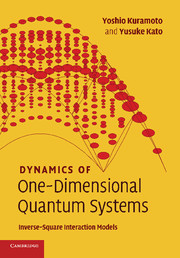Book contents
- Frontmatter
- Contents
- Preface
- 1 Introduction
- Part I Physical properties
- 2 Single-component Sutherland model
- 3 Multi-component Sutherland model
- 4 Spin chain with 1/r2 interactions
- 5 SU(K) spin chain
- 6 Supersymmetric t–J model with 1/r2 interaction
- Part II Mathematics related to 1/r2 systems
- Afterword
- References
- Index of symbols
- Index
2 - Single-component Sutherland model
from Part I - Physical properties
Published online by Cambridge University Press: 12 January 2010
- Frontmatter
- Contents
- Preface
- 1 Introduction
- Part I Physical properties
- 2 Single-component Sutherland model
- 3 Multi-component Sutherland model
- 4 Spin chain with 1/r2 interactions
- 5 SU(K) spin chain
- 6 Supersymmetric t–J model with 1/r2 interaction
- Part II Mathematics related to 1/r2 systems
- Afterword
- References
- Index of symbols
- Index
Summary
In the present chapter, we discuss the Sutherland model for particles without internal degrees of freedom such as spin. We call this model the singlecomponent Sutherland model. For two particles, the eigenenergies and eigenstates of the Sutherland model (1.3) have been obtained explicitly in the previous chapter. The most striking feature of the Sutherland model is that one can derive not only the energy spectrum but also the dynamics for the many-particle case with an exact account of interaction effects. Thus, the Sutherland model provides an ideal framework to study a one-dimensional quantum liquid in detail.
In Section 2.1, we derive the eigenenergies of eigenstates. In Section 2.2, we present different but equivalent physical pictures for the energy spectrum. Namely, the energy spectrum is naturally regarded as that of interacting bosons or fermions. The same spectrum can also be interpreted as that of free particles obeying nontrivial quantum statistics, i.e., free anyons in one dimension. The exclusion statistics proposed by Haldane will be explained on this occasion. Spectrum and statistics of elementary excitations are derived in Section 2.3. In Section 2.4, we discuss thermodynamic properties, which can be rewritten as those of free anyons. In Section 2.5, we identify the eigenfunctions with Jack symmetric polynomials, and discuss their basic properties. In Section 2.6, we consider dynamical correlation functions such as Green's functions and the density correlation function. These quantities are derived with the use of Jack polynomials, and are naturally interpreted in terms of elementary excitations with fractional charge.
The Sutherland model is the simplest model to realize the Tomonaga–Luttinger liquid.
- Type
- Chapter
- Information
- Dynamics of One-Dimensional Quantum SystemsInverse-Square Interaction Models, pp. 21 - 97Publisher: Cambridge University PressPrint publication year: 2009

